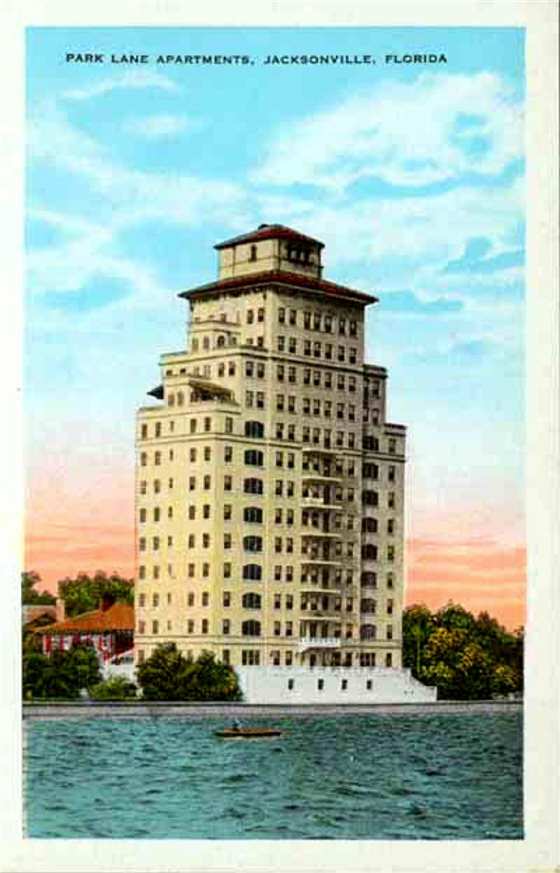- Home
- Lost Attractions
- Sanlando Springs
SANLANDO SPRINGS
By Mike Miller October 12, 2025
OVERVIEW
Sanlando Springs is a natural freshwater spring located in Seminole County, Florida, just west of Longwood, in the greater Orlando region.
The name “Sanlando” is a portmanteau reflecting its location between Sanford and Orlando.
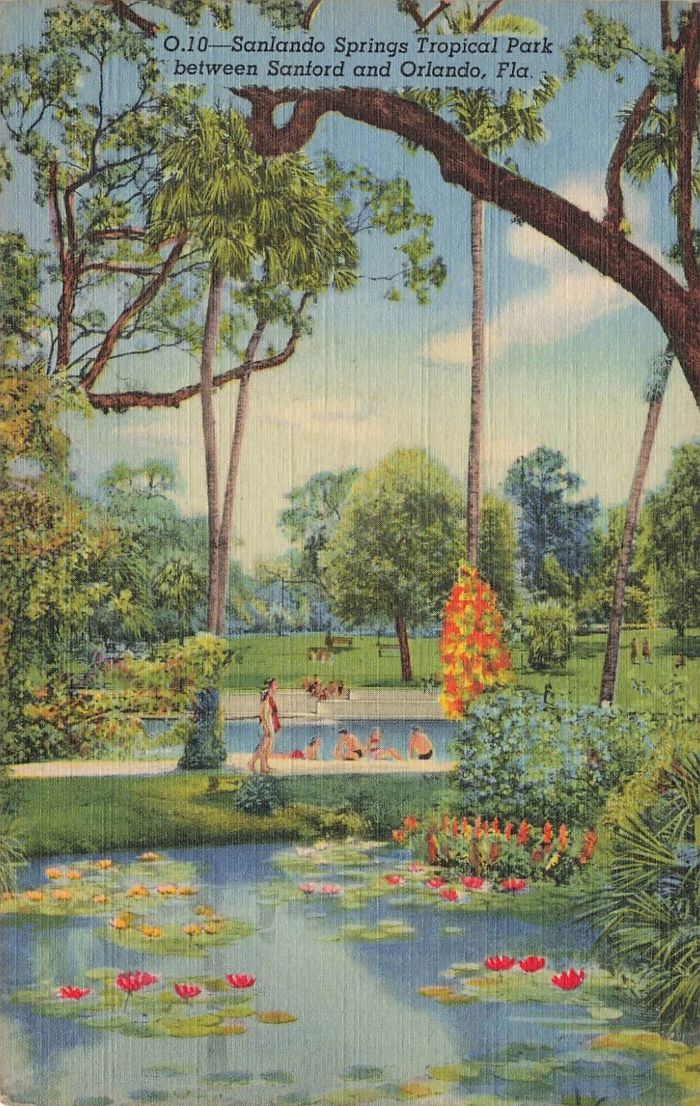 Vintage Postcard Sanlando Springs
Vintage Postcard Sanlando SpringsIn its heyday, the site was operated as a public recreation park, drawing locals and visitors to swim, picnic, and enjoy landscaped tropical gardens and water attractions.
Today, the spring lies within a private gated community (known as “The Springs”) and is no longer open to the general public.
HISTORY
The natural spring was used long before commercial development. Some records trace its recreational use back to the late 19th century—possibly into the 1880s—as a place where locals and travelers cooled off or fished.
In its earlier incarnation, it was called Hoosier Springs.
In 1925 (or 1926), developer James Franklin Haithcox purchased the property, renamed it Sanlando Springs, and began to formalize the site as a recreational attraction.
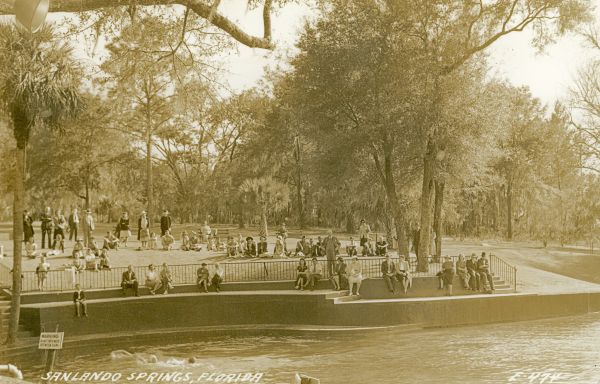 Early Photo Sanlando Springs
Early Photo Sanlando SpringsHe dammed portions of the Little Wekiva River to raise the water level, built landscaping, and added facilities including a bathhouse, pool, and tropical gardens.
Early promotional material mentions a 50-room hotel being built in conjunction with the springs’ development.
During the Florida land boom of the 1920s, such springs and tropical-park settings were popular attractions or selling points in real-estate marketing.
However, the bust and Great Depression forced changes in ownership. The property reverted from Haithcox to Moses Overstreet, who invested in expanded improvements, landscaping, and park amenities.
Later, under J.E. Robinson (mid-20th century), additional attractions like a diving platform and water slide were added.
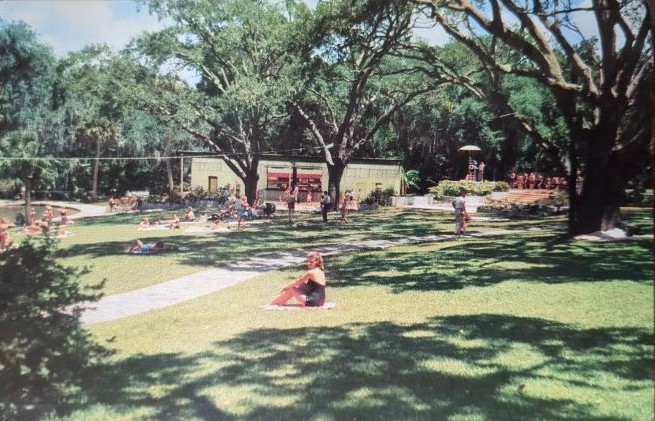 Sanlando Springs
Sanlando SpringsRoad access to Sanlando improved over time. In 1926, Longwood extended Warren Street west toward the springs (now Sanlando Springs Road, aligned with State Road 434) following former railroad right-of-way.
Over the decades, local recognition of the springs and the roadway name reinforced the connection to the area.
FEATURES
Sanlando Springs, in its developed form, offered a blend of natural and man-made amenities:
-
The spring itself is classified as a second-magnitude spring. The vent lies several feet underwater (about 7 feet or so) and is roughly 10 feet wide by 2–3 feet in height.
-
The pooled spring formed a swimming basin roughly 180 ft by 200 ft. Shoreline walls of stone or concrete were installed to reduce erosion and maintain the shape of the pool. A small sand beach area bordered one side.
-
A floating swimming platform (dock) lay about 40 feet out from shore to allow jumping or swimming.
-
Historically, there was a diving board/platform about 6 feet above the water, until later removed by the homeowner association of the gated community.
-
A water slide was another featured attraction, adding to its “tropicalized” amusement-park feel.
- In addition to swimming, the site supported picnic pavilions, landscaped tropical gardens, walking paths, a dance floor, gift shop, snack bar, and cottages for guests or overnight stays.
-
In promotional brochures, the spring’s constant temperature (around 72 °F) was emphasized as both pleasantly cool in summer and mild in winter.
-
As water from the spring pool drains, it flows downstream into the Little Wekiva River, then into Wekiva River, contributing to the regional spring-river hydrology.
- On the periphery, there were several sulfur springs nearby (less suitable for swimming due to odor and possible hazards such as alligators).
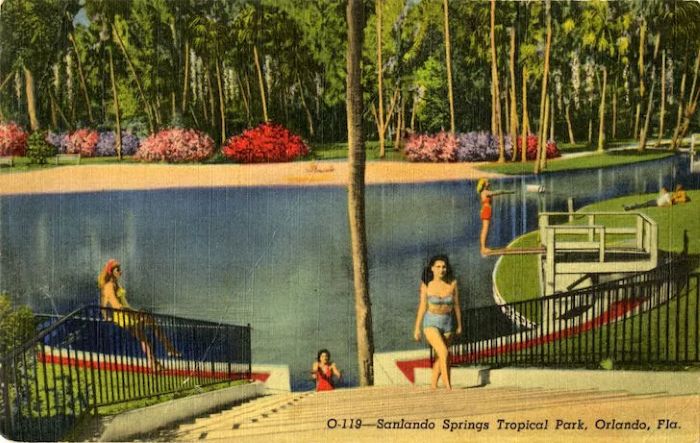 Vintage Postcard Sanlando Springs
Vintage Postcard Sanlando SpringsThese features combined a natural spring with landscaped recreation — making it more than a simple swimming hole, but a full seasonal attraction.
PEAK POPULARITY
From the 1930s through the 1960s, Sanlando Springs was one of Central Florida’s most beloved summer destinations. In an era before ubiquitous air conditioning, theme parks, or major suburban swimming pools, natural springs were attractive refuges from Florida’s heat.
Central Florida residents (from Orlando, Sanford, and surrounding counties) would drive to Sanlando for day trips or weekend stays. The amenities — slide, diving board, gardens, dancing, and nighttime events — gave it a leisure-park feel.
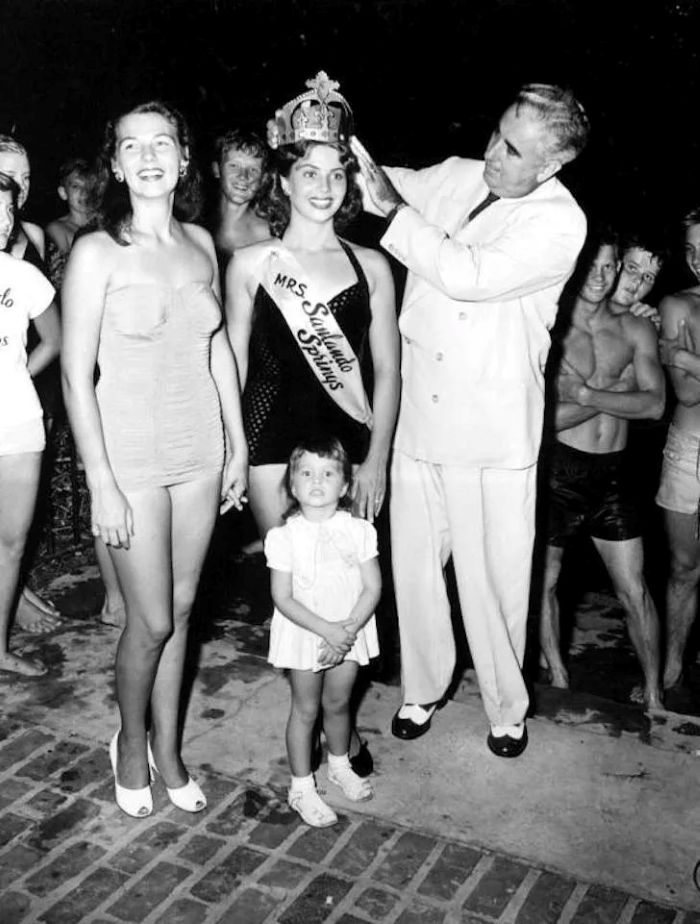 Peggy Creel, Miss Sanlando Springs 1951
Peggy Creel, Miss Sanlando Springs 1951Local youth dances, beauty contests, contests, and social functions were held there. Brochures of the era promoted it as “tropical park” recreation, combining natural beauty with curated fun.
The site’s appeal was partly geographic: positioned between Orlando and Sanford, it was accessible to residents of both locales.
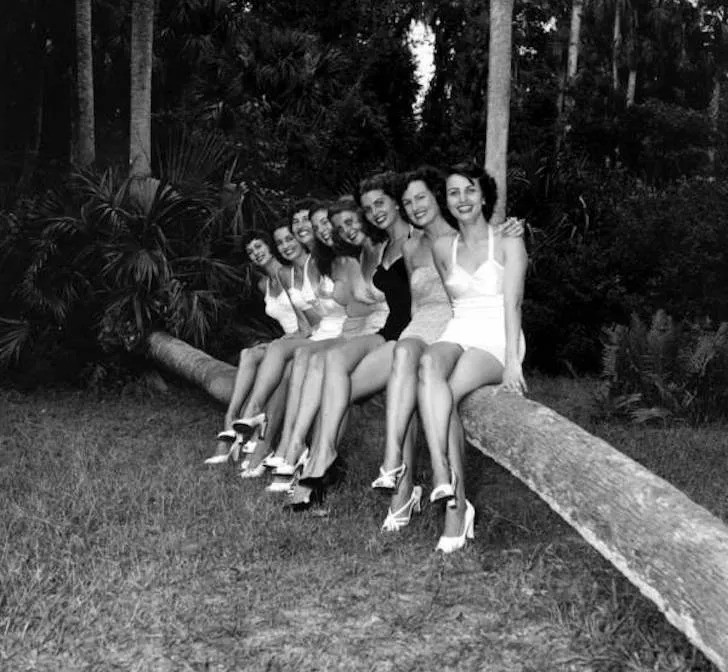 Sanlando Springs Beauties 1951
Sanlando Springs Beauties 1951As suburban development expanded in post–World War II decades, the pool of potential visitors grew. Oral histories reflect how many families used Sanlando as a rite of summer during the 1950s and 1960s.
DECLINE AND CLOSURE
By 1970, Sanlando Springs ceased operating as a public recreation park. The land was sold to developers who converted the site into a private residential subdivision known as The Springs.
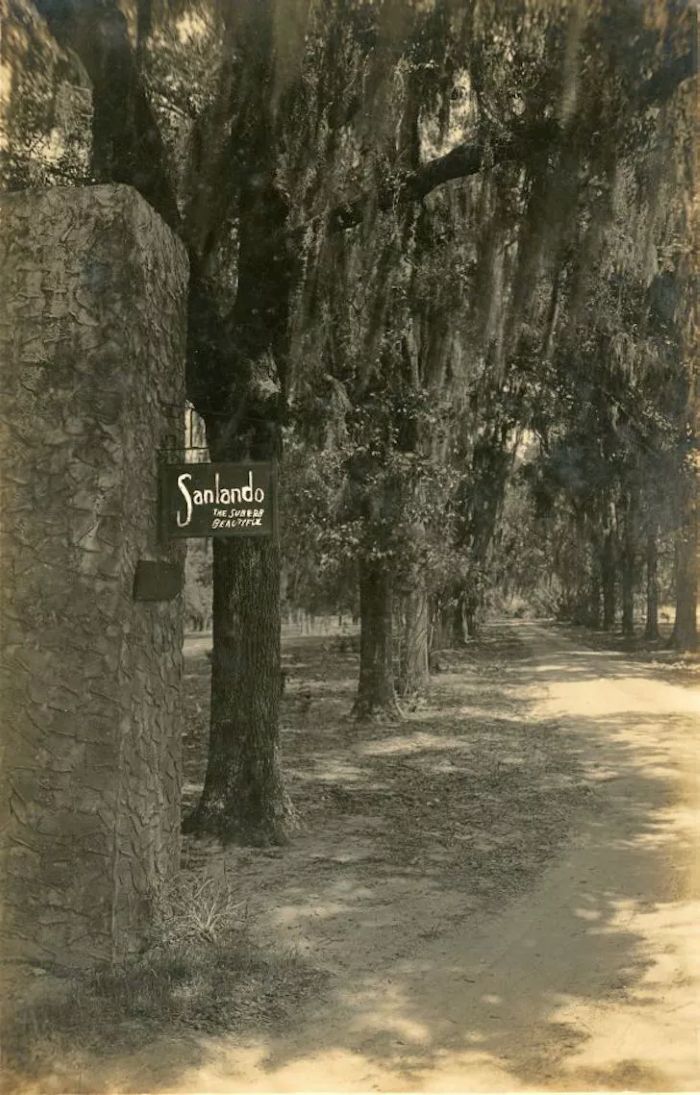 Vintage Photo Sanlando Springs
Vintage Photo Sanlando SpringsPublic access was withdrawn, and only residents or their guests would be allowed use of the springs area. Several factors are probable causes of the closure:
-
Land development pressure: the surrounding area was becoming more valuable for residential subdivision than for a standalone recreational park.
-
Financial sustainability: operating and maintaining park infrastructure, landscaping, water amenities, and liability over time likely became costlier.
-
Shifting leisure patterns: with the rise of major theme parks (Disney, Universal, SeaWorld) and suburban community pools, local springs parks lost competitive draw.
- Legal, regulatory, or liability concerns may have made the public-operation model less viable in a growing suburban context.
After the transition, the diving board and some high-risk features were eventually removed under community governance. Once privatized, the springs were maintained by the homeowner association rather than as a commercial public park.
WHAT'S ON SITE TODAY?
After 1970, the former park grounds were subdivided and developed as residential lots within “The Springs” gated community.
The spring itself lies behind the community’s clubhouse and is accessible only to residents and their authorized guests.
While still under oversight of the St. Johns River Water Management District, the spring no longer operates as a public swimming or recreation facility.
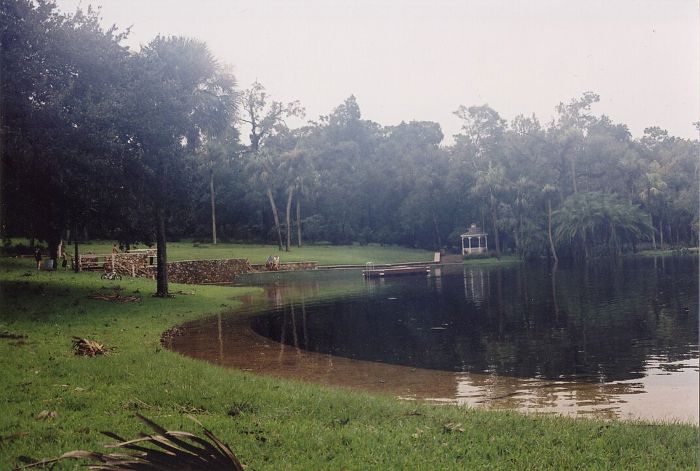 Sanlando Springs 2004, Flooding After Hurricane Frances
Sanlando Springs 2004, Flooding After Hurricane FrancesWikipedia, Taylor Steiner
The diving platform has been removed; but the floating dock and basic pool area remain in use by residents. In times of heavy rainfall or flooding (e.g. during hurricane seasons), portions of the spring may flood or become hazardous.
Some contemporary community events still take place around the spring; for example, in past years, the Orlando Philharmonic performed a “Symphony at the Springs” open event, drawing thousands.
The site remains preserved to some degree but under restricted access and focused on serving the local residential community rather than the public at large.
LEGACY
Although no longer open to the public, Sanlando Springs holds a cherished place in Central Florida memory.
Generations of residents recall family summer outings, diving off the board, slides, shaded gardens, and quiet moments in cool spring water.
In the region’s historic narrative, Sanlando is a reminder of a time when natural springs were centers of local recreation, rather than just ecological preserves or private enclaves.
The name lives on in the road (Sanlando Springs Road, part of SR 434) and the community identity of that area. The spring still contributes to the hydrology of the Little Wekiva / Wekiva River system.
It also features in local historical markers and memory-projects celebrating “Old Florida” and the past recreational springs era.
In academic or local histories of Central Florida recreation, Sanlando is often cited as one of the early model springs-park hybrids — a recreational natural attraction that later succumbed to development pressures.
While the general public cannot now enjoy Sanlando Springs, its memory lives on in photographs, recollections, and the local historical consciousness of the Orlando area.
LOCATION OF SANLANDO SPRINGS

Florida is the fastest-growing state in the United States and also the fastest-changing. If you see anything in this article that has changed or is in error, please let me know.
Thousands of Florida fans subscribe to our free daily Ezine, Florida Heritage Travel and we have 130,000 followers on Facebook.
By Mike Miller, Copyright 2009-2025
Florida-Back-Roads-Travel.com
Florida Back Roads Travel is not affiliated with or endorsed by Backroads, a California-based tour operator which arranges and conducts travel programs throughout the world.
